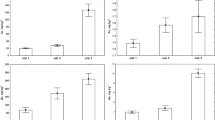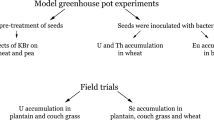Abstract
The purposes of this research were (1) to compare level of uptake and accumulation of Eu and Ce by wheat and rye seedlings grown in soil spiked with these metals, (2) to estimate short-term variations of Eu and Ce in soil and in plants and (3) to study effects of Eu and Ce accumulation on concentrations of other macro- and trace elements in the plants. The experiments were performed in a naturally illuminated greenhouse. Instrumental neutron activation analysis was used to determine concentrations of rare earth elements and essential nutrients and trace elements in the plants and soil. The experimental results indicate that addition of Eu and Ce to soil can lead to enhanced uptake of the trace elements by plants. Plants more easily accumulated Eu than Ce. Moreover, for rye, differences between amounts of Ce in the seedlings grown in Ce-spiked soil and in Ce-free soil were statistically insignificant. During the first hours after transfer of seedlings to soil spiked with Eu, concentration of Eu in the roots of both plant species increased significantly. An increase of leaf Eu concentration was also observed, however, these variations were not as marked as those in roots. During the following 10-day growth in the Eu-spiked soil, concentration of Eu in plants constantly increased. The bioaccumulation of Eu resulted in certain decrease of Eu in the rhizosphere soil. However, no variations in soil Ce concentrations were found. The accumulation of Eu and Ce in rye and wheat seedlings did not significantly affect concentrations of essential plant nutrients and other REEs.





Similar content being viewed by others
References
Adriano, D. C. (2001). Trace elements in terrestrial environments: biogeochemistry, bioavailability, and risks of metals (2nd ed.). New York: Springer.
Ahsan, N., Renaut, J., & Komatsu, S. (2009). Recent developments in the application of proteomics to the analysis of plant responses to heavy metals. Proteomics, 9, 2602–2621.
Babula, P., Adam, V., Opatrilova, R., Zehnalek, J., Havel, L., & Kizek, R. (2008). Uncommon heavy metals, metalloids and their plant toxicity: a review. Environmental Chemistry Letters, 6, 189–213.
Bertoldi, D., Larcher, R., Nicolini, G., Bertamini, M., & Concheri, G. (2009). Distribution of rare earth elements in Vitis vinifera L. Chardonnay berries. Vitis, 48(1), 49–51.
Brioschi, L., Steinmann, M., Lucot, E., Pierret, M. C., Stille, P., Prunier, J., et al. (2013). Transfer of rare earth elements (REE) from natural soil to plant systems: implications for the environmental availability of anthropogenic REE. Plant and Soil, 366(1–2), 143–163.
Bulman, R. A. (1994). Europium and other lanthanides. In H. G. Seiler, A. Sigel, & H. Sigel (Eds.), Handbook on metals in clinical and analytical chemistry (pp. 351–363). New York: Marcel Dekker, Inc.
Challaraj Emmanuel, E. S., Anandkumar, B., Natesan, M., & Maruthamuthu, S. (2010). Efficacy of rare earth elements on the physiological and biochemical characteristics of Zea mays L. Australian Journal of Crop Science, 4, 289–294.
Che, Y., Xing, R., Zhu, Y., Cui, Y., & Jiang, X. (2011). Effects of lanthanum chloride administration on detouring learning in chicks. Biological Trace Element Research, 143(1), 274–280.
Chen, Z. (2011). Global rare earth resources and scenarios of future rare earth industry. Journal of Rare Earths, 29, 1–6.
d'Aquino, L., Morgana, M., Carboni, M. A., Staiano, M., Antisari, M. V., Re, M., et al. (2009). Effect of some rare earth elements on the growth and lanthanide accumulation in different Trichoderma strains. Soil Biology and Biochemistry, 41, 2406–2413.
Diatloff, E., Asher, C. J., & Smith, F. W. (1999). Foliar application of rare earth elements to maize and mungbean. Australian Journal of Experimental Agriculture, 39, 189–194.
Diatloff, E., Smith, F. W., & Asher, C. J. (2008). Effects of lanthanum and cerium on the growth and mineral nutrition of corn and mungbean. Annals of Bototany, 101, 971–982.
Ding, S., Liang, T., Gzhang, C., Huag, Z., Xie, Y., & Chen, T. (2006). Fractionation mechanisms of rare earth elements (REEs) in hydroponic wheat: an application for metal accumulation by plants. Environmental Science & Technololgy, 40, 2686–2691.
Fang, J., Wen, B., Shan, X.-Q., Wang, H.-H., Lin, J.-M., & Zhang, S.-Z. (2007). Evaluation of bioavailability of light rare earth elements to wheat (Triticum aestivum L.) under field conditions. Geoderma, 141, 53–59.
Haferburg, G., & Kothe, E. (2007). Microbes and metals: interactions in the environment. Journal of Basic Microbiology, 47(6), 453–467.
Haxel, G .B., Hedrick, J. B., & Orris, G. J. (2002). Rare earth elements–critical resources for high technology: U.S. Geological Survey Fact Sheet 087–02, 4 p., US Department of Interior, US Geological Survey.
Hu, Z., Richter, H., Sparovek, G., & Schnug, E. (2004). Physiological and biochemical effects of rare earth elements on plants and their agricultural significance: a review. Journal of Plant Nutrition, 27, 183–220.
Humphries, M. (2010). Rare earth elements: the global supply chain. Darby, PA: DIANE Publishing Co.
Jiang, D. G., Yang, J., Zhang, S., & D J., Y. (2012). A survey of 16 rare earth elements in the major foods in China. Biomedical and Environmental Sciences, 25(3), 267–271.
Kulaksiz, S., & Bau, M. (2011). Anthropogenic gadolinium as a microcontaminant in tap water used as drinking water in urban areas and megacities. Applied Geochemistry, 26, 1877–1885.
Lin, X., & Henkelmann, R. (2004). The internal comparator method. Analytical and Bioanalytical Chemistry, 379, 210–217.
Liu, D., Wang, X., Lin, Y., Chen, Z., Xu, H., & Wang, L. (2012a). The effects of cerium on the growth and some antioxidant metabolisms in rice seedlings. Environmental Science and Pollution Research, 19, 3282–3291.
Liu, D., Lin, Y., & Wang, X. (2012b). Effects of lanthanum on growth, element uptake, and oxidative stress in rice seedlings. Journal of Plant Nutrition and Soil Science, 175(6), 907–911.
Liu, D., Wang, X., Zhang, H., & Gao, Z. (2013). Effects of lanthanum on growth and accumulation in roots of rice seedlings. Plant, Soil and Environment, 59(5), 196–200.
Maheswaran, J., Meehan, B., Reddy, N., Peverill, K., & Buckingham, S. (2001). Impact of rare earth elements on plant physiology and productivity: a report for the Rural Industries Research and Development Corporation. Barton ACT: RIRDC.
Ozaki, T., Suzuki, Y., Nankawa, T., Yoshida, T., Ohnuki, T., Kimura, T., et al. (2006). Interactions of rare earth elements with bacteria and organic ligands. Journal of Alloys and Compounds, 408–412, 1334–1338.
Semhi, K., Chaudhuri, S., & Clauer, N. (2009). Fractionation of rare-earth elements in plants during experimental growth in varied clay substrates. Applied Geochemistry, 24(3), 447–453.
Sholkovitz, E. R., & Schneider, D. L. (1991). Cerium redox cycles and rare earth elements in the Sargasso Sea. Geochimica ef Cosmochimica Acta, 55, 2737–2743.
Shtangeeva, I., & Ayrault, S. (2007). Effects of Eu and Ca on yield and mineral nutrition of wheat (Triticum aestivum) seedlings. Environmental and Experimental Botany, 59, 49–58.
Smuc, N. R., Dolenec, T., Serafimovski, T., Dolenec, M., & Vrhovnik, P. (2012). Geochemical characteristics of rare earth elements (REEs) in the paddy soil and rice (Oryza sativa L.) system of Kočani Field, Republic of Macedonia. Geoderma, 183–184, 1–11.
Solanki, R., & Dhankhar, R. (2011). Biochemical changes and adaptive strategies of plants under heavy metal stress. Biologia, 66(2), 195–204.
Tian, H. E., Gao, Y. S., Li, F. M., & Zeng, F. (2003). Effects of europium ions (Eu3+) on the distribution and related biological activities of elements in Lathyrus sativus L. roots. Biological Trace Element Research, 93, 257–269.
Tyler, G. (2004). Rare earth elements in soil and plant systems - A review. Plant and Soil, 267, 191–206.
Vijayaraghavan, K., Sathishkumar, M., & Balasubramanian, R. (2010). Biosorption of lanthanum, cerium, europium, and ytterbium by a brown marine alga, Turbinaria Conoides. Industrial & Engineering Chemistry Research, 49, 4405–4411.
Wang, L., Huang, X., & Zhou, Q. (2008). Effects of rare earth elements on the distribution of mineral elements and heavy metals in horseradish. Chemosphere, 73, 314–319.
Xu, Q. S., Fu, Y. Y., Min, H. L., Cai, S. J., Sha, S., & Cheng, G. Y. (2012). Laboratory assessment of uptake and toxicity of lanthanum (La) in the leaves of Hydrocharis dubia (Bl.) Backer. Environmental Science and Pollution Research, 19, 3950–3958.
Yang, M., Wu, J.-C., & Gu, H.-N. (2012). Study of the relationship between the content of the rare earth element Eu in rice plants and in Nilaparvata lugens (Hemiptera: Delphacidae). Insect Science, 19(1), 13–20.
Ye, Y., Wang, L., Lu, X. H. T., Ding, X., Zhou, Q., & Guo, S. (2008). Subcellular location of horseradish peroxidase in horseradish leaves treated with La(III), Ce(III) and Tb(III). Ecotoxicology and Environmental Safety, 71(3), 677–684.
Zeng, F., Tian, H. E., Wang, Z., An, Y., Gao, F., Zhang, L., et al. (2003). Effect of rare earth element europium on amaranthin synthesis in Amarathus caudatus seedlings. Biological Trace Element Research, 93, 271–282.
Zhang, C., Li, Q., Zhang, M., & Zhang, N. (2013a). Effects of rare earth elements on growth and metabolism of medicinal plants. Acta Pharmaceutica Sinica B, 3(1), 20–24.
Zhang, Y., Ning, Z., Sui, L., & Zhong, H. (2013b). Analysis of samarium and europium in wheat by IC-PMS after on-line separation and preconcentration. Journal of Chemical Society of Pakistan, 35(5), 1298–1303.
Zhao, H., Zhou, Q., Zhou, M., Li, C., Gong, X., Liu, C., et al. (2012). Magnesium deficiency results in damage of nitrogen and carbon cross-talk of maize and improvement by cerium addition. Biological Trace Element Research, 148, 102–109.
Acknowledgements
The author acknowledges financial support of DFG Foundation for fellowship to perform the research and grateful for kindly help and advices of Dr. Dorothea Alber and Gregor Bukalis (Helmholtz-Zentrum Berlin).
Author information
Authors and Affiliations
Corresponding author
Rights and permissions
About this article
Cite this article
Shtangeeva, I. Europium and Cerium Accumulation in Wheat and Rye Seedlings. Water Air Soil Pollut 225, 1964 (2014). https://doi.org/10.1007/s11270-014-1964-3
Received:
Accepted:
Published:
DOI: https://doi.org/10.1007/s11270-014-1964-3




